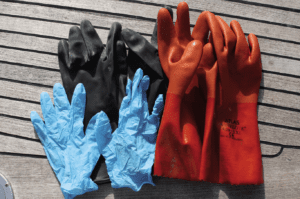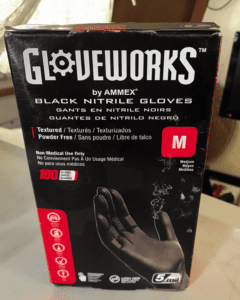We choose our sailing gloves and deck shoes with great care, because they are our interface with the boat. The same goes for work gloves, and choosing the right pair for the job is a tricky balance. In addition to dexterity, we demand physical and chemical protection, durability, and comfort. There is no perfect work glove, but rather a family, each with the optimum properties for the task at hand.
MATERIAL
Materials and coatings vary in strength, grip, and resistance to chemicals. Latex has the best stretch but doesn’t resist chemicals. Nitrile resists oil well and solvents better, but stretches less. Polyurethane provides a good grip— too much for some jobs—resists paint, and is reasonably flexible. PVC gloves offer acceptable resistance to many solvents, but will permeate in time. PVC is a durable coating, but less flexible than latex or nitrile.
The cloth fabric providing structural support comfort can be cotton, nylon, or polyester, with light or heavy weave and varying amounts of Lycra. The lightest gloves can be quite stretchy, providing a form-fit, but this comes at the cost of reduced wear and abrasion resistance.
Finally, there is leather. You don’t see them around the boatyard as much as coated cloth gloves, because gloves are often discarded before they are worn out. Leather doesn’t like being wet, but there is nothing better for heavy work. They excel at dry heat, when a plastic coating will melt and cloth will burn or melt. Welding gloves are always leather with a gauntlet.

CONSTRUCTION
Unsupported gloves, what we think of as examination gloves, come in a range of thicknesses—3-5 mil thickness are super dexterous and flimsy ($0.15-0.20 each), while 5-7 mil thickness are good for light duty painting and epoxy projects ($0.20-$0.35 each). Latex offers superior grip and stretch; it is the material of choice for surgical gloves unless you have a latex allergy. It resists water and water solutions, but they commonly very thin, limiting strength and abrasion resistance. Their resistance to solvents is virtually non-existent; gasoline can destroy a latex glove in a minute, reducing it to a gelatinous mass that falls off your hand, and even less aggressive solvents permeate through in seconds to minutes.
Nitrile resists oil, fuels, and most solvents, but the stretch is less than latex and they are more expensive. These protect us from incidental contact with chemicals solvents and paint, but not for a long soaking; they permeate quickly and puncture too easily.
Heavier unsupported gloves, what we think of as dish-washing gloves, are 12-15 mils and gauntlet style. They have improved resistance to solvent permeation while preserving acceptable dexterity, but lacking a reinforcing fabric, remaining vulnerable to punctures and tears. Wear them under protective gloves for heavier work. Avoid vinyl gloves, which are only suitable for dying hair.
Supported gloves can be either wrist length with an elastic cuff or gauntlet style for liquids. The palms and fingers are coated with one of the above elastomers, and a variety of surface textures are applied. Foamed nitrile grips tools like bare skin does but better. It is a favorite mechanic’s gloves and okay for painting, but it does not wear as well as PVC for tough jobs like scraping and hull cleaning. The aggressive “high grip” textures can have too much grip for many tasks, making it hard to shift the position of the tool, paint brush, or roller in your hand. Smoother finishes are better for most tasks.
STYLE
Coated palm gloves can be latex, nitrile, or PVC. The least expensive are cotton string gloves. The coating is light, so they’ll last only about a day,
but at 50 cents each they make good protective gloves to wear over examination or unsupported gloves.
The next step up are lightweight assembly gloves, commonly used on assembly lines to prevent parts contamination. These feature high-stretch fabric and a thin coating. Typically sold in multi-packs for about $1.60-$2.50 each, they’ll last a day of painting..
We like these for painting and mechanical work, and we consider them semi-disposable. We generally use them for multiple days, but sometimes we toss them after a single hard use. The coating will wear off in a few days of heavy work. Heavier coated palm gloves are good for general work, including sanding, in-water hull cleaning, and of course, gardening, where they outperform leather in wet conditions.
Insulated coated palm gloves are comfortable in dry conditions, and dry rapidly, but they are not for cleaning in cold weather. For that, choose either coated gauntlet gloves or double-coated gloves, described below. Insulated gloves also give additional vibration damping when using power tools.
Double coated gloves are like coated gloves, but with a thin all-over coating that makes them waterproof, plus a second top coating on the fingers and palm to make them durable enough for heavy use. They’re available in an insulated version, which excels at cleaning in cold weather and winter kayaking.
Coated gauntlet gloves are for heavy cleaning and stripping, and working with hot liquids and steam. Oven mitts and leather are good for dry heat, but hot water and steam cut through knit fabrics like a knife thought butter, and the fabric holds the heat on your skin, adding to the burn.
Coated gauntlet gloves are standard for chemical plant and refinery work. Worn standard size, they can be removed by simply hanging your hands down and giving a slight shake, a helpful feature when they’re covered in something messy (elastic gloves have to be peeled off, getting the chemicals on your hands).
CARE AND FIT
Wash them if they are a type you will use again. Gauntlet style gloves are most easily washed by adding a few drops of soap, filling with water, and milking for a few minutes. Rinse and dry standing on end. Coated gloves can go in the wash (or by hand if they’re covered in antifouling dust) followed by air drying, but don’t put them in the drier. Simply washing your hands while wearing the
gloves can be effective and easy. Don’t expect coated gloves to last more than a few seasons, even if lightly used; the coating will become either hard or sticky as it degrades.
For general use, including machine sanding, cleaning, and sailing gloves, a moderately snug—not tight—fit is best. Cold weather gloves should not restrict blood flow, and larger gloves are easier to put on and take off, particularly if your hands are damp. For work that requires more dexterity, including painting and mechanical work, go down a size, and chose either an examination glove or a thin, coated-palm, assembly-style glove. The fit will be slightly snug, with no excess space in the fingertips. Thin coated palm gloves with Lycra backs are meant to be worn snug. Like shoes, the best gloves are the ones that fit you.
In cold weather, remember the old construction worker’s adage, “If your hands are cold, put on a hat.” Overdressing forces the heat out your finger tips. By wearing a pair of insulated Carharts and a hat you’ll be able to work on the coldest days in deck shoes and thin gloves. Depending on the task, wear either thin-coated gloves that allow the sense of touch the work requires, or wear something thicker and work bare-handed as needed. Double-coated gloves are perfect for working with water in the winter.
At the hardware store, look for coated gloves in packs of 3-10. These often provide the lighter weight and snugger fit you want for painting and mechanical work. Check the women’s gardening
glove selection; the regular glove section is often skewed toward men with large hands. The gardening department also often has lighter weight options. Auto parts stores will have mechanics gloves, but they are overpriced and generally don’t carry smaller sizes.

DOUBLING UP
Sometimes a job requires two types of glove, for example:
Cleaning with solvents. If the work is quick (15 minutes or less) or light, like stripping a winch, a nitrile examination glove will usually do fine. If the job is longer or more rigorous, wear a coated glove over the nitrile glove, or wear heavy gauntlet style gloves. Nitrile is preferred for heavy exposure to more aggressive solvents, because PVC becomes slick. PVC is fine for mineral spirits and lighter exposures that doesn’t involve a full soaking.
Painting. Nitrile examination gloves will keep your hands clean and allow a good sense of touch for small jobs. It is also ideal for epoxy, because you will need to change gloves every 5-10 minutes. As the epoxy kicks, the gloves begin sticking to everything and neat work becomes impossible. They’re cheap and the job will proceed more efficiently if you replace them freely, for a net cost savings.

For bigger jobs like varnishing or painting the cabin or deck, we usually stay with nitrile examination gloves, changing often as they become sticky. If we’re rolling the topsides, a pair of snug-fitting, nitrile-coated, lightweight assembly gloves give better control and protection. We probably don’t need anything under them, because we’re working neatly and won’t get more than a few dabs on the gloves. Because they are breathable, your hands won’t be sitting in pools of sweat for hours. Assembly gloves also provide adequate protection to light sanding and scraping.
Lightweight nitrile-coated, supported gloves are best. We like to work fast, so messes happen mixing paint, working in tight spots, replacing rollers, or grabbing the brush that fell in the roller pan. We use a short roller extension for leverage and reach (about 2-4 feet, depending on the boat), and coated gloves give better grip. Examination gloves are too fragile and uncomfortable. For added protection against paints with strong solvents, you can use a gauntlet style.
Stripping. Anything that will penetrate layers of paint will permeate both gloves and skin. Gauntlet style gloves, double-coated with a thick layer of PVC, nitrile, or Viton are standard for this work. Add nitrile examination gloves under these (changed every hour) if you are using an NMP-based stripper (See “Boatyard Chemical Wisdom,” PS July 2017). Don’t use coated palm gloves, even with nitrile examination gloves under them. Your skin will soak up everything that permeates the gloves, and many stripping chemicals will permeate almost any glove material. The solution is to rotate through several pairs of re-usable PVC, nitrile, or Viton gauntlet gloves, and to frequently change the nitrile gloves beneath them.
Working with corrosives. When working with acids and alkalis, gauntlet style gloves are the go-to glove. Examination gloves can easily get a small hole, after which they hold the liquid against your hand and burn.
Sanding. Vibration attenuation and grip are what you want for machine sanding. For extended sanding projects you can get the special anti-vibration gloves, which are expensive one trick ponies, or you can wear a pair of uncoated knit gloves, or even old sailing or cycling gloves, under a pair of coated-palm gloves. Insulated coated-palm gloves are also good for vibration and breathe well.
Tight spaces. If there’s no room for gloves, but there is a knuckle-scraping hazard that needs tamed, consider athletic tape, commonly available in ½-inch and 1 ½-inch widths. Wrap a knuckle or wrist for protection. An x-wrap around finger joints pads the tendons and reduces strain (see “Prevention Plan for Finger Tendon Injuries,” PS July 2019).
There are dozens of brands, and models are constantly changing. The following is a listing of a few that have stood out in each category. Don’t stock up; coated gloves tend to go hard after a few years.

COTTON STRING GLOVES
All of the cotton string gloves that we tried offered good fit and were a good choice for disposable protection over nitrile examination gloves when painting bottoms. Since they cost about 42 cents each, you won’t care about getting paint on them and disposing of them when done. These are good for rough, messy jobs where you would like to throw away the glove when finished. One size fits all, equivalent to medium /large. About $5 for a pack of 12.
LIGHTWEIGHT COATED PALM (ASSEMBLY GLOVES).
We tested Kaygo nitrile (KG18NB08), Bellingham Wondergrip polyurethane, General Glove PUG-17 polyurethane, and ACKTRA Ultra-Thin Polyurethane Safety Work Gloves (WG002). All had good fit will last all day, but you won’t mind throwing them away. Prices range from $1.25-$3.50 each. The Milwaukee Cut Level 1 nitrile glove (48-22-8902) is good, but more expensive. Choose one size smaller for painting and mechanical work. Nitrile (often abbreviated N) coatings are best, polyurethane (often abbreviated PU) is good, and PVC is OK, but less common because it does not stretch as well.

COATED-PALM, GENERAL PURPOSE WORK GLOVE.
The industrial-grade, latex rubber coated Atlas Fit 300, is the gold standard. This good first choice for sanding and general heavy work, but solvents will cause them to get slick and quickly fail. Some dinghy racers cut the finger tips off and use them as sailing gloves. There is also an insulated version, Atlas thermal, for $5.50 each. These offer good vibration absorption in a durable, economical glove. This is also popular among some recreational and commercial fisherman.
HEAVY DUTY GAUNTLET COATED GLOVE
The Ansell / Edmont Snorkle has been a favorite in refinery service for 50 years, this is the top choice for a double-dipped, heavy-duty, vinyl coated high gauntlet glove. We wore these daily, summer and winter. They handle everything—cleaning, turning wrenches, scraping, etc. The downside is they are thick and clumsy, but costing about $6, they will last most sailors a decade. They are a safe choice for stripping and heavy duty cleaning, including very hot water. They will protect your hands. If it’s really cold, slip a thin glove inside.
DOUBLE COATED
The Kinco Hydroflector 1786P is insulated, making it very warm in cold, wet conditions. The grip is excellent. We prefer them over $100 Goretex gloves for winter kayaking, handling cold wet ropes, or washing the car in mid-winter. Costing about $12, they’re not bad for sailing in the cold rain either. Don’t downsize or you will never get them on and off without any dampness.
LEATHER GLOVES
Leather is great for heavy work. There are dozens of good ones to choose from and everyone has their favorite. Any reinforced areas should be well-stitched and not so stiff as to interfere with the near perfect fit these gloves can provide. A good pair will cost only about $15. Small sizes are hard to find, so people with diminutive digits will have to look elsewhere for a good fit.
BOTTOM LINE
Gloves are as specialized as shoes, so the material, construction, and required fit will vary depending on the job. An assembly-glove style, with foamed nitrile coated palm, sized down one size, is our favorite for painting and general mechanical work. But we supplement these with many other types, according to the project. Finally, don’t forget retired sailing gloves. Ours are always repurposed for rough carpentry, non-greasy mechanical work, and pushing the mower. They are, after all, a specialized sort of work glove.
VALUE GUIDE: WORK GLOVES FOR BOATERS BY TYPE
| TYPE | MAKER | MODEL | MATERIAL | COATING | RECOMMENDED SIZING | PRICE | QUANTITY | EACH |
|---|---|---|---|---|---|---|---|---|
| STRING GLOVES | Various | Various | Cotton/ polyester | Latex, nitrile, or PVC | One size | $5 | 12 | $0.42 |
| NITRILE PALM | Kaygo | KG18NB08 | Nylon/ spandex | Nitrile foam | Down one size | $32 | 12 | $2.67 |
| PVC PALM | Kaygo | KG15P09 | Nylon / spandex | PVC | Down one size | $22 | 12 | $1.83 |
| NITRILE PALM | Bellingham | Wondergrip | Nylon / spandex | Nitrile foam | Down one size | $6.75 | 3 | $2.25 |
| POLYURETHANE PALM | Global Glove | Pug 17-M-12 | Nylon / spandex | Polyurethane | Down one size | $16 | 12 | $1.33 |
| PVC PALM | Acktra | Ultrathin WG02 | Nylon / spandex | PVC | Down one size | $15 | 12 | $1.24 |
| LATEX PALM THERMAL | Atlas | Atlasfit 300/ Thermal | Nylon/ spandex | Latex | Standard | $5.50 | 1 | $5.50 |
| HEAVY GAUNTLET | Ansell/ Edmont | Snorkle | Polyester flocked | PVC | Standard | $6 | 1 | $6.00 |
| DOUBLE COATED | Kinco | Hydroflector 1786P | Polyester/ acrylic | Latex | Standard | $12 | 1 | $12.00 |
| NITRILE DISPOSABLE | Gloveworks | 5 mil nitrile black | Nitrile | None | Standard | $17 | 100 | $1.70 |




































